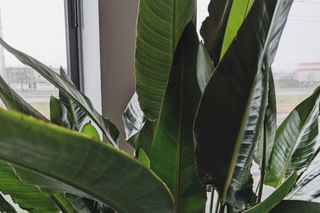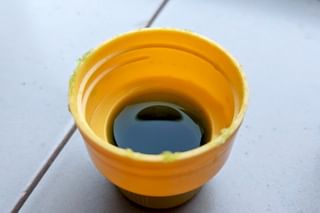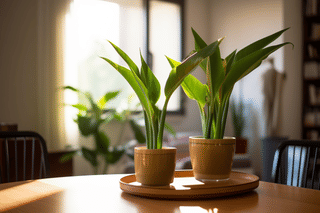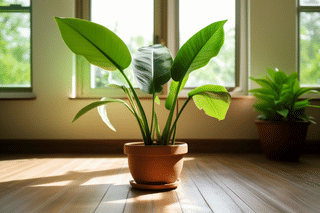How to care for a Bird of Paradise (Strelitzia)
The Bird of Paradise is one of the most well-known tropical houseplants. Surprisingly, it's quite easy to take care of this plant. In this plant care guide, we're going to find out how you can best take care of this beautiful and fast-growing tropical houseplant.
The Bird of Paradise is one of the most well-known tropical houseplants. It looks a lot like the Banana plant and it's easy to confuse the two. Unlike most tropical plants, the Bird of Paradise is easy to take care of and is a great option for tropical plant-loving beginners.
The Bird of Paradise, also known as Strelitzia reginae, Strelizia nicolai, or just Strelitzia is a fast-growing tropical plant that gets big. It's a houseplant that you need to have space for because it's too large for smaller houses. It can get as big as 1.80m (6ft) tall and 1.20m (4ft) wide.
In this plant care guide, we're going to look at a few different parts of taking care of your Bird of Paradise:
Let's find out how we can take care of the Bird of Paradise!
Watering your Bird of Paradise
The Bird of Paradise is a tropical houseplant. Like many other tropical plants, the Strelitzia prefers to be in moist soil most of the time. Like an Alocasia Zebrina, the Strelitzia has thick stems that store a lot of moisture. This helps to keep the plant healthy and hydrated when it's getting a little dry.
Most plants like their soil to dry out in between watering, but the Strelitzia is not one of those plants. It's important to keep the soil moist at all times. The Bird of Paradise has huge leaves, through which it loses a lot of moisture. During the spring and summer, you will have to water your plant about twice per week.
When you're watering your Bird of Paradise, make sure not to water too much. This plant doesn't like to sit in wet soil and this will cause root rot over time. A simple trick is to use a pot with a drainage hole to let the excess water escape from the pot.
Another way to check the soil at the bottom of the pot is to use a moisture meter. These plants become quite large, so you might not be able to use a pot with a drainage hole. A moisture meter will help you to make sure you're not watering your plant too much.
Watering in winter
During the fall and winter, when your Strelitzia becomes dormant and doesn't use as much energy to grow, you can water less as well. You should still make sure the soil is moist all the time, but you can water a little less: about once per week.
Brown edges
If you notice brown edges on the leaves of your Bird of Paradise, you've most likely overwatered it. When you see this, let the soil mostly dry out before watering your plant again. This is when you should let some extra oxygen reach the roots of your plant to recover. The easiest solution is to let the soil mostly dry out before giving it more water.
Yellow leaves
If you've underwatered your Strelitzia, you'll see yellow leaves on your plant. When you see this, just water your plant and make sure to keep its soil moist in the future. The yellow leaf won't turn green again, but your plant will be happy.
Sunlight exposure
Photo by Luca Deasti on Unsplash
The Bird of Paradise loves bright sunlight, including direct sunlight. This means that it is the perfect plant for a spot close to your windows where it gets a lot of bright light. The Strelitzia doesn't mind direct sunlight, but it's important to keep it away from the harsh afternoon sun in the summer. Direct sunlight in the afternoon is too harsh for the large Strelitzia leaves and could leave burn marks.
An ideal place would be a spot near a window that gets direct sunlight in the morning or evening. In this spot, your Bird of Paradise will get plenty of sunlight and energy to grow quickly. The Strelitzia doesn't do well in a poorly lit room, as it needs bright sunlight to grow properly.
Sunlight exposure in winter
During winter, remember to check the sunlight your Bird of Paradise plant gets. These plants love bright, indirect sunlight in warmer months. In winter, though, they might need extra care to stay healthy and well-lit.
So, how much sunlight does a Bird of Paradise need in winter? Ideally, these plants should receive at least 4-6 hours of direct sunlight per day or up to 12 hours of indirect sunlight.
Since the sun is weaker in winter, it's important to make sure your Bird of Paradise is getting enough sun and consider its placement. To make sure your plant is getting enough winter sun, consider moving it to a south-facing window where it can soak up the most sun.
If sunlight is still not enough, some artificial light could be a nice solution. LED grow lights are a popular option for indoor plants, and can even be set on timers to provide consistent lighting, meaning there is still a day-night cycle.
Temperature and Humidity for your Bird of Paradise
If you're looking to keep a Bird of Paradise plant happy and thriving, providing it with the right temperature and humidity is essential. Ideally, these tropical plants prefer daytime temperatures ranging from 18 to 24 degrees Celcius (65 to 75 F) and nighttime temperatures between 10 to 13 Celcius (50 to 55 F).
When it comes to the humidity levels, you should try to keep this above 50%, but ideally, keep it in the range between 60% to 70%. If the air in your home is naturally dry, using a humidifier to increase humidity levels is a good solution. Another solution is to mist your Bird of Paradise plant's leaves regularly with a spray bottle filled with water.
It's also important to keep your Strelitzia away from cold drafts or heat sources. If your plant is too close to radiators or drafty windows, the temperature changes can harm or even kill your Bird of Paradise.
Soil for your Strelitzia
Photo by Neslihan Gunaydin on Unsplash
Earlier, we discovered that the Strelitzia likes to be in moist soil at all times. However, it's also important not to let it sit in wet soil. The perfect soil for your Bird of Paradise should be soil that retains moisture well but lets the excess water escape quickly. You can buy pre-mixed potting soil for this or make it yourself.
The most important ingredients of the soil should be:
- Potting soil
- Perlite
- Peat moss
The potting soil contains the nutrients your plant needs to grow into a big and healthy houseplant. The perlite helps your soil drain excess moisture quickly and provides a bit of structure.
The structure of your soil is very important because you don't want the soil to compact too much over time. When you water your plant often, the soil will want to compact and become more dense. Perlite, but also peat moss, helps the soil keep its shape and prevents the soil from becoming too dense. When the soil becomes dense, the moisture won't drain as easily and it won't allow oxygen to reach your plants' roots, which will cause root rot.
Lastly, the peat moss is great at retaining moisture and keeping the soil light and airy. This helps to promote healthy root growth.
The combination of these three ingredients will make sure that your Strelitzia gets the perfect amount of moisture and still gets oxygen at its roots.
Leca
If the soil mix seems too complicated and you don't want to have to worry about overwatering your plant, you can always use Leca. Leca is great for watering your plant perfectly, while still making sure oxygen gets to your plant's roots.
Fertilizing your Strelitzia
Your Strelitzia is a fast-growing houseplant. Like other fast-growing houseplants, it uses a lot of energy to grow this quickly. Most of this energy is from the bright sunlight, but you will also need to fertilize it to keep it healthy.
Especially during the spring and summer, this plant uses a lot of nutrients to put out huge new leaves. During this time, you should fertilize your plant once per week with a liquid fertilizer mixed in with the water. You can also use a slow-release fertilizer if you want a solution that takes less effort.
During the fall and winter, you shouldn't fertilize your Strelitzia. Your plant will most likely be dormant and won't absorb much of the fertilizer. When too much fertilizer stays in the soil, it can become acidic, which makes it a bad place for plants to grow.
There are many great ways to fertilize your Strelitzia. If you want to know which fertilizer works best for you and your Bird of Paradise, have a look at "What is the best type of fertilizer for houseplants?".
Pruning your Bird of Paradise
Keeping your Strelitzia healthy and looking its best takes a bit of pruning from time to time. Pruning your plant can improve its overall appearance, remove diseased or damaged parts, and stimulate new growth.
Feel free to prune your Bird of Paradise plant whenever necessary. Start by removing any dead, yellow, or damaged leaves. Use sharp and clean pruning shears for clean cuts. Avoid jagged cuts to prevent any infections. You can also trim wilted flowers to encourage new blooms.
If you notice any stems that are crossing or rubbing against each other, you can trim them to prevent damage and improve air circulation. When cutting stems, make sure to cut them off as close to the base of the plant as possible, because these stems won't regrow. Instead, you'll want to make space for new stems to grow.
As for when to prune your Strelitzia, the best time is during its growing season, when the plant is actively growing. The growing season usually lasts from early spring to late summer, When you prune your plant during this time, it has a chance to recover quickly. However, if you need to remove dead or damaged leaves or flowers, you can do that at any time of the year.
Can I keep my Bird of Paradise plant smaller by regular pruning?
The Strelitzia is a large plant, but you can control its size by regularly pruning any unwanted stems. By pruning these stems, you keep the plant a little smaller, but you also encourage new (bushier) growth.
One thing to keep in mind when pruning Strelitzia plants is that they can be sensitive to over-pruning. While it's important to keep the plant in check, too much pruning can cause stress and affect the health of the plant. I recommend pruning your Strelitzia once or twice a year, depending on the size and growth rate of the plant.
Propagating your Strelitzia
The easiest way to get more of the same plant is by propagating them. Propagating a Strelitzia is very easy, as you can propagate them through division. In this section, we're going to look at the steps to take to propagate a Birth of Paradise plant.
To get started, you need 3 tools:
- Sharp knife
- Pruning scissors (or normal scissors)
- Rubbing alcohol to disinfect your tools
- Make sure you have multiple shoots in a single pot. You'll be able to tell if you do if there are multiple sources of stems coming out of the soil. If all stems are coming from 1 source, you only have 1 plant and you can't propagate yet.
- Remove the plants including the soil out of their pot to expose the root system
- Remove as much of the soil by hand as you can
- Separate the root systems of the different plants in the pot. You might need your (disinfected) knife to help you with this, but try carefully separating them by hand first. Using a sharp knife to cut the two plants from each other might seem violent, but your plant will recover quickly.
- Pot up each plant in their own pot and you'll have successfully propagated your Strelitzia.
Now it'll take some time for each plant to grow new off-shoots, but in a year or so, you can repeat this process to get even more of these plants. If you'd prefer a video to help you with this process, I can highly recommend My city plants' guide on dividing the Strelitzia. You'll see how easy this process can be.
Can I use stem cuttings or do I need to divide the plant?
If you're wondering whether you can do stem cuttings to propagate the plant, instead of propagating it through division, I've got bad news. This is not possible.
If you want to propagate a plant using stem cuttings, you'll need a stem that has nodes on it. These nodes are filled with growth hormones to promote root growth after propagation. However, the Strelitzia doesn't have any nodes on the stems, but only in its base, near the roots. That's why this is the source of all new stems.
So if you want to propagate this plant, you'll have to do so through division.
Repotting your Bird of Paradise
You must repot your Bird of Paradise plant regularly to ensure its health and growth. It loves soil that drains well and has lots of organic matter. Typically, repot your Strelitzia every two to three years or when it outgrows its current pot.
Here are some steps to successfully repot your Bird of Paradise:
Choose the right time: The ideal time to repot your Bird of Paradise is in early spring when it is just starting to grow. Avoid repotting during the winter or summer months when the plant is dormant or in a state of stress.
Select the right pot: Choose a pot that is one to two sizes larger than the current pot and offers some way to keep your plant's roots from standing in a puddle of water at the bottom of the pot after watering. Ceramic or terra cotta pots are great options for Strelitzia plants.
Remove the plant from its current pot: Stelitzias are large plants, so the easiest way to remove the plant from its current pot is by holding onto the stem of the largest plant, lifting it, and gently tapping on the pot to loosen it from the soil. The pot should fall off quite easily.
Trim the roots: Once the plant is out of the pot, trim the roots by removing any brown, dead, or damaged roots. This will encourage new root growth and a healthier plant.
Add fresh soil: Add fresh potting soil to the new pot, leaving enough room for the plant's roots.
Repot the plant: Place the plant in the new pot and fill in with soil, gently pressing down around the roots. Make sure not to pack the soil too tightly or the roots won't get enough oxygen.
Water the plant: Give the plant a good watering to help it settle into its new home. Water the Strelitzia until the excess water drains out of the pot. Allow the soil to dry out slightly before watering again.
Common pests
Like many other tropical plants, the Bird of Paradise is vulnerable to a few different pests, including Mealybugs and scale. These are tough pests to get rid of, but there are ways to help your plant quickly.
The best way to treat these pests is to use neem oil. Neem oil is a natural essential oil that's very effective against these pests on a Strelitzia. When you do notice these pests on your plant, be sure to spray the neem oil on all leaves and also on the bottom of the leaves. Repeat this process every day for a week and the pests will be gone.
It's also a great idea to use neem oil as a preventive measure against pests. If you regularly spray your Strelitzia with Neem oil, the risk of getting any pests is significantly lower. Spraying your plants as a prevention can help you in the long run.
Common problems and diseases
Plants, the Strelitzia, can be prone to diseases and problems that affect their growth. Identifying and treating these issues early on is crucial to prevent further damage. Let's tackle them head-on and make sure your plant stays healthy long-term.
Some common problems or diseases that can affect a Bird of Paradise plant include stunted growth and fungal infections. Stunted growth is commonly caused by a lack of light or the use of the wrong type of soil. Most fungal infections are caused by overwatering, high levels of humidity, or too little air circulation.
To identify these problems, you should regularly check your Bird of Paradise plant's leaves, stems, and roots. Check if there are any signs of discoloration, wilting, or drooping, or if the soil is too wet or too dry. If you suspect that your plant has a disease, isolate it from other plants to prevent the spread of the disease.
To treat these problems, you can start by changing its environment such as light exposure, humidity, and soil type to make sure that the plant receives the right growing conditions. Also, remove any infected or dead leaves or roots and avoid overwatering your Strelitzia plant. In some cases, you can apply a fungicide or insecticide to get rid of pests or fungi that may cause problems.
Making sure your Strelitzia is healthy is an ongoing process, so regularly checking and adjusting care where needed is important.
Flowering
Photo by Thimo van Leeuwen on Unsplash
The Bird of Paradise grows flowers. These flowers grow in the late winter and early spring, but only under certain conditions. First of all, it takes at least 3 years before it will start to grow any flowers. Flowers only grow on mature plants and it takes about 3 years before the plant is mature enough to support flower growth. Second, it only grows flowers if it's getting plenty of sunlight and has been well taken care of.
It's quite a rare sight to see the flowers if you're keeping the Strelitzia as a houseplant, it's more likely to happen if it grows in its natural environment.
Caring for your Bird of Paradise in winter
As the winter months approach, it's important to make sure that your plant receives the appropriate care to thrive and survive during this season. Here's how you should care for your Bird of Paradise plant during the winter months:
-
Keep it warm: The ideal temperature for these plants is around 18 to 24 degrees Celcius (65-75 F). Make sure that your Bird of Paradise is away from cold drafts (like open windows or doors), as they can cause harm to the plant.
-
Cut back on watering: During the winter months, the soil tends to dry out (much) slower than in warmer months. Allow the top inch of the soil to dry out in between watering, and make sure there's proper drainage to avoid waterlogging.
-
Provide humidity: Bird of Paradise plants need high humidity to thrive. During the winter, when central heating is running every day, the air becomes much dryer, so it's a good idea to get a humidifier or use pebble trays with water under your plant.
-
Stop fertilization: During the colder months, your plant's growth slows down, which means your plant won't need the nutrients. Don't fertilize your Strelitzia during the winter as the fertilizer can make the soil become acidic.
-
Check for pests: Winter months are the perfect environment for pests like spider mites and scale insects. Inspect your plant regularly for any signs of pests and treat them immediately if spotted.
-
Keep the plant in the light: Bird of paradise plants need bright light to grow. Make sure your plant gets enough sunlight by placing it near a window with sufficient light. This is especially important in the winter, as the sun is weaker.
Less is more when it comes to taking care of the Strelitzia during the winter. You won't have to spend as much time on it as you do in the spring and summer.
Should I move a Strelitzia indoors for the winter?
Whether you should move your Strelitzia indoors during the winter depends on several factors, such as your location, climate, and the current condition of your plant.
In general, Strelitzia plants thrive in warm and humid environments, with temperatures ranging from 18 to 24 degrees Celcius (65-75 F). If you live in a region that experiences harsh winters, you will have to bring your plant indoors to protect it from frost and cold drafts.
However, if you live in a temperate or tropical climate and your Bird of Paradise is healthy and well-established, it can thrive outside year-round.
If you're unsure whether to move your Bird of Paradise indoors or leave it outside, it's best to play it safe and bring it indoors for the winter.
Toxicity for pets
The Strelitzia stems and leaves are not toxic to your pets, but the flowers and seeds are. Luckily, these flowers are quite rare when you grow your Bird of Paradise indoors. Overall, if your Strelitzia isn't growing any flowers, it's relatively safe to have this plant around your pets.
If you see your pets getting nauseous and suspect they've eaten the plant, make sure to call a veterinarian to ask for advice.
Conclusion
The Bird of Paradise, also known as a type of Strelitzia, is a fast-growing houseplant that can become quite large. It's relatively easy to take care of this tropical plant, which might come as a surprise to you. This fact plus its vibrant and fast-growing nature, makes it an enjoyable houseplant for both beginners and seasoned plant enthusiasts.
Another surprise is that the plant is relatively safe around pets, but only when they're not growing flowers. With adequate sunlight, the right soil conditions, and mindful watering practices, your Bird of Paradise will flourish, transforming your home into an indoor jungle. As with all living things, attentive care and understanding of their needs are key.
Overall, the Bird of Paradise is an amazing plant that you can put in any bright place in your house. Hopefully, with this guide, you can begin creating your own indoor, tropical paradise with the magnificent Bird of Paradise and help it thrive!
Thank you for reading this post! I hope it helps you to keep your plants healthy and beautiful! If you're looking for more guides on specific plants, you can always request a plant guide to get a guide for the plant you have trouble with.
Test your plant care knowledge
Quiz completed!
Want to learn more? Sign up for my newsletter to receive free tips in your inbox!
Sign up now!


















